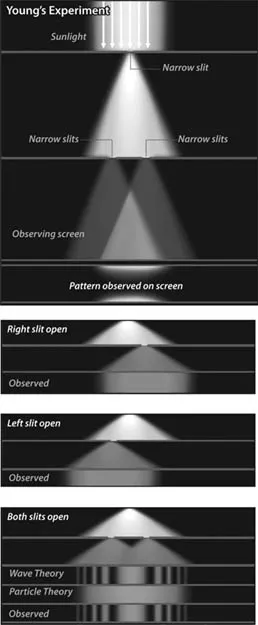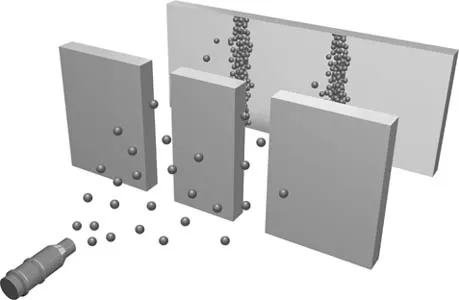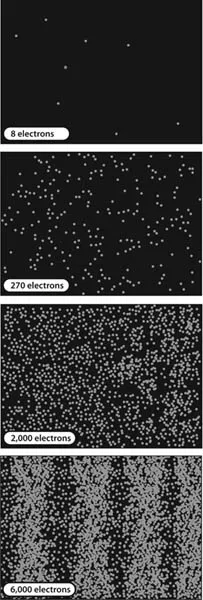![]()
PART I.
THE FIVE SECRETS FROM SCIENCE FOR CREATING THE LIFE OF YOUR DREAMS
![]()
1. CHOOSING WITH THE UNIVERSE
Possibility Served Up on a Platinum Platter
FROM THE MOMENT YOU WERE CONCEIVED, you’ve been swimming in a sea of possibility. You are constantly surrounded by invisible and unlimited possibility, the brilliant and untapped potentiality of the universe. Possibility pulses inside you, waiting for the signal to explode into the world. Possibility, as a quantum physicist would put it, is being amplified into reality every second all around you. Are you watching for it? Can you see it?
In that sea of possibility lies your dream. It’s right there, waiting for you to choose it, waiting for you to turn on the magnificent power inside you that can bring it to life. Right beside it are the dreams you haven’t allowed yourself to have yet, the bigger, bolder versions of your dream that I encourage you to discover and embrace with all your being.
In this chapter, I show you how to drench yourself in possibilities, and how to take the first steps in selecting the ones that have the most meaning for you. You’ll learn how to expand your awareness of the possibilities available to you while, at the same time, consciously and deliberately selecting some and discarding others. By choosing, you define your destination and kick off what I call your Possibility Amplification Process. This book will teach you how to get the most from that process. But first you must select from this unlimited sea. You can’t amplify something that you haven’t first selected.
The truth is that the universe is made up of possibility, and through our conscious and deliberate observation we have the power to make the universe choose specific possibilities out of all those available and amplify them into reality. In this chapter, I share with you two versions of an experiment that proved this to be true: the double slit experiment with light, and the double slit experiment using individual subatomic particles. This power is fundamental to the realization of your dreams, and it’s a power you already possess, just like every other human being on the planet. What you’ve lacked until this moment is the technology to access it. In this chapter, we take step 1 in the Possibility Amplification Process, and that step is composed of observing, choosing, and recording the possibilities you want to amplify into reality.
My first job is to convince you that the universe is indeed made of possibility, and that you can access it. The experiments I describe in this chapter have been explained and written about many times, and you can find additional information about them in the science section of your local library or bookstore. I present them to you here in order to extract the basic principles of the first step of the Possibility Amplification Process.
THE DUAL NATURE OF EVERYTHING
In the late 1700s, a huge debate was going on in the scientific community. Some scientists said light was made up of “corpuscles,” or little clumps of “stuff,” and other scientists said light was made of waves. In 1801, a physician and physicist named Thomas Young devised an experiment that answered the question for all time. It’s called the double slit experiment.
Young surmised that if light were really made of waves, then it would demonstrate the same properties that waves on the surface of water demonstrate. One of those properties is called interference, which is what happens when two waves run into each other. Young’s experiment was designed to test for wave interference in light.
You’ve probably created wave interference yourself. Imagine this: You’re standing on the edge of a calm, quiet pond. In each hand you hold a good-sized pebble. Holding your hands out in front of you, you drop the two pebbles in the pond. As soon as the pebbles hit the surface of the water, rings of ripples pulse outward from the places where the pebbles struck. The rings of ripples grow until finally the ripples from one dropped pebble collide with the ripples from the other dropped pebble. As the ripples collide, the smooth arcs of the ripples break up and the surface of the water where they collide becomes choppy. The two waveforms interfere with each other and become distorted, in some places amplifying each other and in other places canceling each other out. This effect is known as wave interference. Young designed his double slit experiment to look for evidence of light crashing into itself like those ripples on the pond.
You can see in Figure 1 how Young set up the experiment. First he created a barrier with one slit in it, so that the light shining through the slit would be coherent — that is, if light was indeed made of waves, it would come through the slit as a single, coherent wave. The light passing through the slit would then shine on a second barrier with two slits placed close together. As light passed through these two slits and landed on the screen behind it, either it would create two vertical lines of light, or it would show evidence of these two streams of light interfering with each other, just like waves of water do.
FIGURE 1. The setup and results of Dr. Young’s famous double slit experiment.
Young discovered that when he made the slits larger and spaced them far apart, two vertical bands of light would appear on the screen. This is what physicists who believed light was made of particles would expect. It’s also much like dropping a pebble in a pond while your friend drops a pebble at the same time on the opposite shore of the pond. The waves from your pebble disperse before they can interfere with the waves caused by your friend’s pebble, so far away.
But as he made the slits smaller and moved them closer together, multiple bands of light appeared on the screen, rather than just two. Young knew that this kind of pattern could only be caused if light was made of waves. As the wave of light passing through one slit collided with the wave of light passing through the other slit, the two waves interfered with each other. Some parts of the light waves were amplified, and some were cancelled out, causing alternating bands of light and dark on the screen. If he closed one of the slits, the multiple bands of light disappeared and just one band of light appeared on the screen. That’s what Young expected, since there was only one wave and no interference.
It took many years for the scientific community to accept the fact that light is indeed made of waves, but eventually the conclusion became inescapable. In the years that followed, evidence to support the particle nature of light also mounted. What we know today is that light is made of both waves and particles, but even more important, that everything is made of both waves and particles. Every subatomic particle demonstrates the properties of both, whether that subatomic particle is part of a beam of sunshine or part of your shoe.
Now, why would the universe be constructed in such a way that it would need two modes? Let’s take the science a little bit further.
THE POWER OF OBSERVATION
In the twentieth century, physicists were able to take Young’s experiment to the next level by firing one photon—or particle—of light at a time through the slits. They did this using a photon gun.
Imagine for just a moment that the scientists were using a real gun, rather than a photon gun, to fire bullets at two vertical slits in a wall. Any bullet that made it through one of the slits would embed itself in a barrier on the other side of the wall. The pattern that would eventually build up on the barrier would look like the one in Figure 2.
FIGURE 2. What would happen if real bullets were fired from a gun at the double slits?
If you were firing one photon at a time from a photon gun, wouldn’t the results be the same? It turns out that the answer is no. The physicists watched in amazement as, over time, what built up on that back barrier (in this case, a piece of photographic film) was instead a wave interference pattern. You can see what that looks like in Figure 3.
But wait a minute. What were the individual photons interfering with? If they were being fired one at a time, they each had to choose only one slit to pass through . . . didn’t they? Or was it possible that one photon could pass through both slits simultaneously?
FIGURE 3. The wave interference pattern appears when subatomic particles are fired one at a time at the double slits.
The physicists decided to check. They closed one of the slits. When they did so, all the photons passed through the single slit, one after the other, and landed in a bullet-type arrangement on the screen beyond the slit, just like in Figure 2. In other words, the photons acted like particles instead of waves. So what was happening when both slits were open? In order to find out, the physicists used a recording device to determine through which slit each photon actually went.
This is where it gets even crazier. When the physicists watched to see which slit the photons passed through, the photons acted like bullets again and created a pattern like the one in Figure 2. When the recording device was turned off, the photons went right back to behaving like waves and built up a wave interference pattern like the one in Figure 3. It was as if the photons knew we were watching.
This experiment has been done over and over, around the world, using not only photons but also electrons, which are particles from the atoms that material objects, like your shoe, are made of. Richard Feynman, a Nobel Prize—winning physicist, said in his physics lecture series at the California Institute of Technology during the early 1960s that in this quantum mechanical experiment is “a phenomenon which is impossible, absolutely impossible, to explain in any classical way, and which has in it the heart of quantum mechanics. In reality, it contains the only mystery.” By classical, Feynman means according to the physical rules that govern our everyday world. Specifically, the phenomenon to which Feynman refers is: observation modifies outcome.
Wow. Think about what that means: just looking at the universe changes the way it behaves. Let’s review for a moment. If both slits are open, even a single photon or electron fired at a time demonstrates its wave properties — by spreading out, keeping loose, and behaving more like a smear of energy than a defined dot. In a way, it’s as if the photon is keeping all its options open. But if we record or observe which slit the subatomic particle goes through, it abandons its wavelike properties, becomes a solid particle again, and chooses a specific destination. It’s almost as if, by recording what “choice” the particle makes — which slit it goes through — the observer creates a history for the particle that it can’t escape and, in this way, affects its future.
The dual nature of the universe and the impact of our observation on that nature are at the heart of accessing possibility. Using the strengths of both waves and particles, we can begin to amplify our desired outcomes into reality.
WAVE MODE VERSUS PARTICLE MODE
Remember back in high school, when they showed you a picture of an atom? There was a little nucleus at the center, and electrons circled the nucleus in succinct orbits like planets? Well, it turns out that’s not really what an atom looks like or how electrons behave. Within a certain distance of the nucleus, the electron is actually everywhere at once. A quantum physicist would say the electron is in “all possible states at the same time,” creating a “cloud of possibility” around the nucleus.1 This is known as a superposition. (You’ll read more about superposition in chapter 2.)
And it’s not just the electron that’s in all possible states at the same time and keeping all of its options open. It’s every particle in the atom. In other words, all subatomic matter is simply a vibrating collection of possibilities. And since everything in the universe is made up of subatomic material, everything in the universe is made up of that possibility. Including you. So, you are in fact a being made of possibility, swimming in a sea of possibility. That’s the wave mode.
When the electron — or any other subatomic particle — is in the particle mode, all its other possibilities have been suppressed and only one possibility is selected. Quantum physicists call this “collapsing the state.” In particle mode, a choice has been made. After that, all activity is about that singular choice.
There are only a few forces that can cause a subatomic particle to choose one possibility out of all the possibilities available to it. As we have just seen, our observation is one of those forces, and we’ll talk more about that in just a minute. First, let’s talk about how you can access these modes and use them to your advantage.
GETTING INTO WAVE OR PARTICLE MODE
Electrons, like other subatomic particles, are able to be everywhere at the same time when they are in wave mode. In wave mode, all possibilities are available.
You, too, have a wave mode, when all possibilities are available to you. These are the moments before making decisions, or before choosing your next course of action. When you’re in wave mode, it’s a great time to imagine the results you want to achieve or the dream you will make come true. The wave mode is jam-packed with answers, ideas, and inventions just waiting for you to ask for them.
Getting into wave mode is a function of asking the right questions. Questions that start with “if” are wonderful wave mode kick-starters. Here are some great questions to get you into wave mode:
If this could work, how would it work?
If I did know the answer, what would it be?
If I started today, what could I get done by the end of the week?
If I had the one critical resource I need to make this happen, what would it be?...




